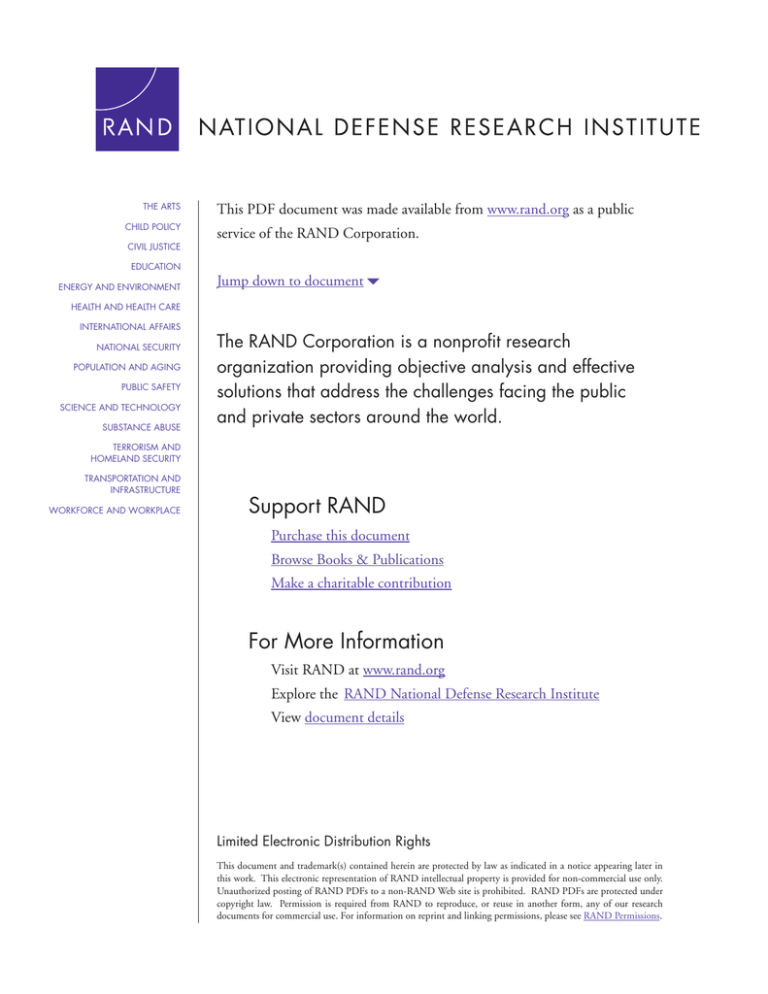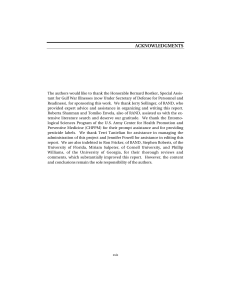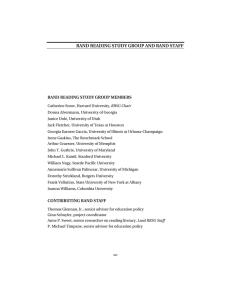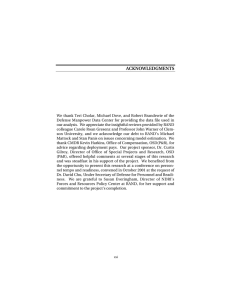
THE ARTS
CHILD POLICY
CIVIL JUSTICE
EDUCATION
ENERGY AND ENVIRONMENT
This PDF document was made available from www.rand.org as a public
service of the RAND Corporation.
Jump down to document6
HEALTH AND HEALTH CARE
INTERNATIONAL AFFAIRS
NATIONAL SECURITY
POPULATION AND AGING
PUBLIC SAFETY
SCIENCE AND TECHNOLOGY
SUBSTANCE ABUSE
The RAND Corporation is a nonprofit research
organization providing objective analysis and effective
solutions that address the challenges facing the public
and private sectors around the world.
TERRORISM AND
HOMELAND SECURITY
TRANSPORTATION AND
INFRASTRUCTURE
WORKFORCE AND WORKPLACE
Support RAND
Purchase this document
Browse Books & Publications
Make a charitable contribution
For More Information
Visit RAND at www.rand.org
Explore the RAND National Defense Research Institute
View document details
Limited Electronic Distribution Rights
This document and trademark(s) contained herein are protected by law as indicated in a notice appearing later in
this work. This electronic representation of RAND intellectual property is provided for non-commercial use only.
Unauthorized posting of RAND PDFs to a non-RAND Web site is prohibited. RAND PDFs are protected under
copyright law. Permission is required from RAND to reproduce, or reuse in another form, any of our research
documents for commercial use. For information on reprint and linking permissions, please see RAND Permissions.
This product is part of the RAND Corporation technical report series. Reports may
include research findings on a specific topic that is limited in scope; present discussions of the methodology employed in research; provide literature reviews, survey
instruments, modeling exercises, guidelines for practitioners and research professionals, and supporting documentation; or deliver preliminary findings. All RAND
reports undergo rigorous peer review to ensure that they meet high standards for research quality and objectivity.
Finding Candidate Options
for Investment
From Building Blocks to
Composite Options and
Preliminary Screening
Paul K. Davis, Russell D. Shaver,
Gaga Gvineria, Justin Beck
Prepared for the Office of the Secretary of Defense
Approved for public release; distribution unlimited
NATIONAL DEFENSE RESEARCH INSTITUTE
The research described in this report was prepared for the Office of the Secretary
of Defense (OSD) and draws also on research for the Missile Defense Agency
(MDA). The research was accomplished in the Acquisition and Technology Policy
Center (ATPC) of R A ND’s National Defense Research Institute (NDR I), a
federally funded research and development center sponsored by the OSD, the Joint
Staff, the Unified Combatant Commands, the Department of the Navy, the Marine
Corps, the defense agencies, and the defense Intelligence Community under Contract
W74V8H-06-C-0002.
Library of Congress Cataloging-in-Publication Data is available for this publication.
ISBN 978-0-8330-4219-4
The RAND Corporation is a nonprofit research organization providing objective analysis
and effective solutions that address the challenges facing the public and private sectors
around the world. RAND’s publications do not necessarily reflect the opinions of its
research clients and sponsors.
R® is a registered trademark.
© Copyright 2008 RAND Corporation
All rights reserved. No part of this book may be reproduced in any form by any electronic or
mechanical means (including photocopying, recording, or information storage and retrieval)
without permission in writing from RAND.
Published 2008 by the RAND Corporation
1776 Main Street, P.O. Box 2138, Santa Monica, CA 90407-2138
1200 South Hayes Street, Arlington, VA 22202-5050
4570 Fifth Avenue, Suite 600, Pittsburgh, PA 15213-2665
RAND URL: http://www.rand.org
To order RAND documents or to obtain additional information, contact
Distribution Services: Telephone: (310) 451-7002;
Fax: (310) 451-6915; Email: order@rand.org
- xi -
SUMMARY
This report describes and documents a methodology and a prototype tool, the Building
Blocks to Composite Options Tool (BCOT), for identifying investment options suitable for a
particular capability area. The methodology assures that a broad range of investment options is
considered initially. It then uses a screening technique to narrow the range of options to those
deemed worthy of more-extensive assessment in a fuller portfolio-analysis framework, which can
be done using RAND’s Portfolio-Analysis Tool (PAT). The methodology draws upon some
classic techniques from economics and operations research but extends them significantly and
suggests pragmatic approximations in applications, particularly in capabilities-based planning.
We document the prototype methodology using an implementation in Analytica,® although we
have a version built in Microsoft Excel® as well. We use both versions because each has specific
advantages and disadvantages.
BCOT’s basic functioning is summarized in Figure S.1. The steps in the flow are as
follows:
1. Identify investment building blocks (e.g., a particular new aircraft or a new weapon).
Many of these will be available from pre-existing proposals, but a more
comprehensive set can be constructed for a given capability area by defining the
mission, working through alternative ways of accomplishing the mission, noting the
component capabilities and related systems that would be necessary, and highlighting
those that do not presently exist and would therefore have to be developed.
2. Construct all possible composite investment options, i.e., all combinations of the
building blocks.
3. Evaluate the composite options by cost and effectiveness and as a function of test
scenarios, base-force effectiveness, and assumption sets (sets of values for the
parameters used in defining scenarios, performing calculations, and characterizing
costs borne by the capability area).
4. Find the set of options that are economically efficient (on or near the efficient frontier,
also called the Pareto-optimal frontier) for each of many effectiveness functions,
which differ in the relative weight given to scenarios (screening focus) and the
assumptions set used for parameter values.
5. Construct the combined set of options that are near the efficient frontier in at least one
case of interest (i.e., a particular focus or choice of parameter values), as well as their
effectiveness for other choices of focus or assumption sets.
- xii -
6. Review the results manually, discarding further options, while perhaps adding some
options back from the discard pile.
Figure S.1
Summary of BCOT’s Logical Flow
The first three steps are straightforward. Step 4 extends the efficient-frontier methods of
economic theory and operations research; it retains not only options that are on the efficient
frontier, but also some that are near enough to that frontier so that we hesitate to delete them in an
approximate screening procedure. The criterion for retention is how close an option is to the
efficient frontier and whether it is redundant with a less costly option, i.e., has the same effective
building blocks but also some additional blocks that add costs but not value. BCOT automatically
deletes most such redundant options.
- xiii -
Step 5 is also unusual and is a manifestation of our confronting uncertainty seriously. The
options that seem economically efficient depend sensitively on numerous assumptions, such as
the relative importance ascribed to the different scenario test cases (focus), assumptions affecting
the effectiveness calculation, and so on. Rather than making an allegedly “best estimate” of all
these matters and then using the options that appear most efficient for that best estimate, we
combine the options that are efficient with different choices of focus and assumptions sets. In an
analysis based on three test scenarios, this might mean keeping options that are efficient for each
one of the scenarios—even if not for an average of the three. Similarly, if results are sensitive to
some parameters, such as assumed warning time or the quality of adversary forces, we define
different cases corresponding to different combinations of parameter values. Again, it may be
that an option appears economically efficient for one case but not for another. We retain an
option that is attractive for any of the cases of interest. Although this may seem only logical and
straightforward, it is unusual; accomplishing it in a program also proved to be nontrivial.
Step 6, manual review and adjustment, is essential because BCOT is ultimately a
mathematical tool that cannot incorporate all of the information known to the analyst. For
example, the analyst may recognize that an option that survived screening did so only because the
effectiveness calculation ignored a fatal flaw for real-world operations. Conversely, an option
may need to be restored because it has strong proponents and would provide extra virtues not
included in the BCOT effectiveness calculation. This extra step of bringing to bear human
expertise should not be seen as compromising methodology, but rather as something desirable.
BCOT will have done its job well if it broadens the scope of considerations beyond what would
otherwise have applied and then narrows it to a sufficiently small number of candidate options so
that manual review and adjustment is practical. In our prototype work, BCOT generated
thousands of options, narrowed them to a set of perhaps three to 100, depending on assumptions,
and provided displays that we could use to review and adjust our calculations in a matter of hours
or days, rather than weeks or months.
Figure S.2 is a less technical depiction of the same flow, making the point that we may
begin with perhaps ten building blocks, construct thousands of possible combinations, evaluate,
screen, and end up with perhaps five to 20 composite options meriting further study.
- xiv -
Figure S.2
Simplified Depiction





